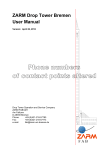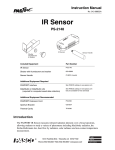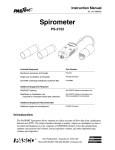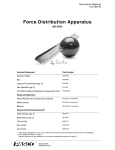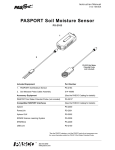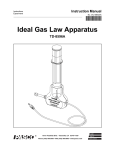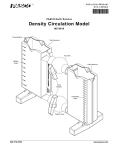Download PASCO Specialty & Mfg. ET-8593 User's Manual
Transcript
Instruction Manual Manual No. 012-08428A Energy Transfer Solar Model No. ET-8593 Energy Transfer Solar Model No. ET-8593 Table of Contents Equipment List........................................................... 3 Introduction ............................................................. 4 Equipment Description .................................................. 4 Equipment Setup ..................................................... 5-6 Suggested Experiments ................................................. 7 Experiment 1: Solar Heating and the Greenhouse Effect .......................................................... 7-8 Experiment 2: Solar Constant (Advanced Lab) ....................................................................... 9-10 Sample Data/Results...................................................11 Appendix A: Temperature/Resistance Conversion Table ............12 Appendix B: Technical Support ....................................... 13 Appendix C: Copyright and Warranty Information .................. 13 2 ® Model No. ET-8593 Energy Transfer - Solar Energy Transfer - Solar Model No. ET-8593 Equipment List 1 3 2 4 Included Equipment 1. Solar Box , 10.75 x 8.25 x 2.50” Replacement Model Number* 648-08412 2. Plastic Cover, 11.0 x 8.25 x 1.25” 650-065 3. Aluminum Plate, 6.50 x 9.0”, 85 g 648-08413 4. Cable assembly 514-08366 *Use Replacement Model Numbers to expedite replacement orders. Additional Equipment Required PASPORT™ Xplorer or a laptop computer PS-2000 DataStudio® software Various (See PASCO catalog) Temperature Sensor or Thermistor Sensor or Ohmmeter/Multimeter PS-2125 or CI-6527A (For ohmmeter, see PASCO catalog.) Piece of cardboard (1 ft. square) NA A computer NA ® 3 Energy Transfer - Solar Model No. ET-8593 Introduction The Energy Transfer-Solar box (ET-8593) can be used for demonstrating the concept of solar heating, including the greenhouse effect. Equipment Description a) Plastic Cover The clear, plastic cover snaps onto the Solar box and acts as insulator to isolate and trap air inside, reduce convection currents, and demonstrate the greenhouse effect. The cover is very transparent to visible light but not infrared light. b)Aluminum Plate The aluminum plate is painted a non-reflective flat black that absorbs light very well. The hot aluminum plate re-radiates in the far infrared region, and thus the heat energy is trapped under the cover. The reverse side of the aluminum plate is not painted. The plate can be flipped inside the box to study differences in solar heating and/or cooling between the aluminum and black surfaces. The aluminum plate can be removed to measure its mass. The white, plastic knob also serves as an indicator for the sun’s angle. When the sun is perpendicular to the aluminum plate, no indicator shadow appears on the plate. c) Solar Box The Solar Box holds the aluminum plate and plastic cover. On the side of the box is a rod clamp for mounting the box to a rod stand. When mounted to a rod stand, the box can be adjusted to the sun’s angle. d) Thermistor Inside the Solar Box is a 10K thermistor for measuring temperature. The thermistor cables are not removable from the box. The thermistor contact (metal lug) is fastened in the center, on the underside of the aluminum plate. The side jacks on the Solar Box allow you to connect a Temperature Sensor or ohmmeter to the thermistor. 4 Note: The thermistor’s temperature range is -35oC to +135oC (242,800 to 265 ohms). ® Model No. ET-8593 Energy Transfer - Solar Equipment Setup Note: A rod stand is required for adjusting the Solar Box to the sun’s angle. 1. Remove the thumbscrew on the aluminum plate. Place the thermistor lug underneath the center hole on the aluminum side of the plate. Insert the thumbscrew through the hole. On the black side, put the shadow indicator over the screw and tighten (See Figure 1). thumbscrew thermistor cable thermistor lug Figure 1: Thermistor position 2. Place the aluminum plate inside the Solar Box, with the black side face up. (Note: Keep the thermistor contact on the underside of the plate.) 3. Snap the bottom and top tabs of the clear, plastic cover onto the Solar Box. (See Figure 3). 4. Using the thermistor cable, connect the Temperature Sensor (or Thermistor Sensor) to the two jacks on the side of the Solar Box (Figure 2). If a Temperature Sensor is not available, connect an ohmmeter to the side jacks. Figure 2: Connecting the thermistor cable 5. Use the rod clamp (on the side of the Solar Box) to mount the base of the Solar Box to a rod stand (Figure 3). 6. Adjust the angle of the box such that the sun's rays enter the box perpendicularly. Use the white knob indicator as a guide. ® Figure 3: Mounting the Solar Box to a rod stand 5 Energy Transfer - Solar Model No. ET-8593 Note: If there is no shadow on the plate, the sun’s rays are perpendicular to the plate. 7. Plug the Temperature Sensor into a PASPORT Xplorer. To take a temperature reading, click the Start button on Xplorer. (Note: The Xplorer data can later be uploaded into DataStudio and viewed in a DataStudio graph display.) OR If you are using an ohmmeter (instead of a Temperature Sensor), turn on the meter and take a resistance measurement. To find the temperature, use the resistance-to-temperature conversion chart in Appendix A.). WARNING: To avoid burns or bodily injury, when heating the box, do not overheat the box (above 100oC) and do not touch either side of the aluminum plate or the thermistor contact. OR If you are using a laptop and a temperature probe, plug the Temperature Sensor plug into a USB port on your laptop computer. Launch DataStudio and click the Start button to collect data. CAUTION: Overheating the box may permanently damage the thermistor and the plastic lid. The thermistor’s maximum temperature capacity is 135oC. 6 ® Model No. ET-8593 Energy Transfer - Solar Suggested Experiments Experiment 1: Solar Heating and the Greenhouse Effect Equipment Required Energy Transfer - Solar (ET-8593) Temperature Sensor (PS-2125) or Thermistor Sensor (CI-6527A) or an Ohmmeter/Multimeter Rod Stand (ME-9355) PASPORT Xplorer (PS-2000) or laptop computer Piece of cardboard Temperature vs. Resistance Chart (See Appendix A) DataStudio Software Part I: Solar Heating 1. Mount the box with plate to a rod stand, such that the Sun's angle is perpendicular to the aluminum plate and the white plastic knob has no shadow. Keep the black side of the aluminum plate facing up (See Figure 4). Figure 4: Setup for Solar Heating Experiment 2. Use a PS-2000 Xplorer or a laptop computer for data collection. Set the sample rate in either Xplorer or DataStudio for 2 Hz. 3. Have a piece of cardboard available to shade the box while setting up. 4. In DataStudio, click the Start button to begin data collection and remove the cardboard shade. 5. With the plastic cover on, take a run of data in DataStudio. Let the box heat until the temperature levels off. (The approximate duration is 10 to 30 minutes, depending on the outside temperature and the intensity of the sunlight.) ® CAUTION: Overheating the box may permanently damage the thermistor and the plastic lid. The thermistor’s maximum temperature capacity is 135oC. 7 Energy Transfer - Solar Model No. ET-8593 Note: Watch the angle of the sun. The angle of the sun must be 90 degrees to the box while you are collecting data. You might have to adjust the angle of the box during the run. 6. Repeat step 5 with the plastic cover off. Analysis 1. Look carefully at both curves at the start of the run. The slope (rate of heating) for the uncovered box should be larger than for the covered box. Why? 2. Which has the highest final temperature, the covered box or the uncovered box? WARNING: To avoid burns or bodily injury, when heating the box, do not overheat the box (above 100oC) and do not touch either side of the aluminum plate or the thermistor contact. 3. Which curve has a more constant heating rate? Why? Part II.Solar Heating Comparison: Aluminum vs. Black Surface Compare the aluminum side up to black side up with the cover on. Which surface is a better absorber of energy? Look at not only how fast the plate heats up, but collect data long enough to look at the final temperature. The black side should heat up much faster than the aluminum side, but does the black side reach a higher final temperature? Part III. Cooling Comparison: Aluminum vs. Black Surface For both sides (aluminum and black), start with the plate hot (Let it sit in the sun), and then move the plate to the shade to watch it cool. Which surface cools faster? Which is a better emitter of energy? Try cooling both with and without the cover on the Solar Box. 8 ® Model No. ET-8593 Energy Transfer - Solar Experiment 2: Solar Constant Equipment Required Energy Transfer - Solar (ET-8593) Temperature Sensor (PS-2125) or Thermistor Sensor (CI-6527A) Rod Stand (ME-9355) PASPORT Xplorer (PS-2000) or laptop computer Piece of cardboard Measuring tape and scale DataStudio Software *Note: This is a more advanced lab. Two Temperature Sensors or one temperature sensor and a thermometer are required. You will use one Temperature Sensor to measure the temperature of the aluminum plate and a second Temperature Sensor (or thermometer) to measure the ambient temperature. 1. Disconnect the thermistor from the plate and measure the mass of the plate. Measure the plate’s size and calculate the area of plate. 2. Cool the plate to 10oC to 20oC below the outside temperature. (You can stick the plate in a refrigerator or use an ice cube). Be sure the plate is dry. 3. Place the aluminum plate in the Solar Box with the black side facing up to the sun. Do not use the plastic cover. 4. Connect the Temperature Sensor to the side jacks of the box with the supplied cable. (If possible, have a second temperature sensor measuring outside temperature. Note: The second Temperature Sensor (or a thermometer) must be in the shade for an accurate determination of the outside ambient air temperature.) 5. Recheck the sun’s angle. You might have to adjust the box relative to the sun’s angle during the run. (Note: The angle of the sun relative to the box must be 90 degrees.) 6. In DataStudio, create a graph of temperature vs. time. For the time variable, use seconds (not minutes) on the graph. WARNING: To avoid burns or bodily injury, when heating the box, do not overheat the box (above 100oC) and do not touch either side of the aluminum plate or the thermistor contact. CAUTION: Overheating the box may permanently damage the thermistor and the plastic lid. The thermistor’s maximum temperature capacity is 135oC. 7. In DataStudio, click the Start button to begin recording (at the default sample rate of 2 Hz.). Heat the box until it is 10oC to 20oC above outside temperature. ® 9 Energy Transfer - Solar Model No. ET-8593 Analysis a) Find the slope of the line tangent to the curve at outside ambient air temperature. Do not use the Slope Tool. Highlight a small section at outside ambient temperature. At ambient temperature, the heating is only being caused by the sunlight. Below the ambient temperature, the surrounding air is cooling the container. Above the ambient temperature, the surrounding air is heating the container. slope = ∆T -------- = change in temperature/change in time ∆t b) Theory for heat flow Q = mc∆T where Q =heat, c=specific heat, and ∆T = change in temperature ∆T Q = Power = ---mc ------∆t ∆t ∆T mc ------∆t Intensity = Power ----------------- = --------------Area Area where ∆ T-----∆t is the slope of the graph. c)Using your slope and the other measured quantities, calculate the intensity of the sun's light. The intensity (solar constant) at the top of the Earth's atmosphere is about 1400 Watts/m2. On a good clear day with the sun high in the sky, you can get over 1000 Watts/m2 on the surface. For Further Study: a) Compare the intensity at noon to later in the day. b) Compare a clear day to a slightly overcast day. c) Compare summer to winter. 10 ® Model No. ET-8593 Energy Transfer - Solar Sample Data/Results Experiment 1: Solar Heating The covered box has the final higher temperature. With the covered box, the greenhouse effect occurs. Light enters the transparent cover, but the infrared light is not re-radiated back out. The infrared light heats the plate. Also, the cover traps the hot air inside the box, isolating and insulating the air. Experiment 2: Solar Constant Note: This data was taken late in the afternoon. ∆ TQ- = mc -----Power = ---= (0.085 kg) (900 joules/kg/oC) (0.361) = 27.6 watts ∆t ∆t Intensity = 27.6 watts/0.038 m2 = 730 watts/m2 ® 11 Energy Transfer - Solar Model No. ET-8593 Appendix A: Resistance/Temperature Conversion Table Resistance (Ohms) 32,660 31,040 29,500 28,060 26,680 25,400 24,180 23,020 21,920 20,880 19,900 18,970 18,090 17,260 16,460 15,710 15,000 14,320 13,680 13,070 12,490 11,940 11,420 10,920 10,450 10,000 9,574 9,166 8,778 8,408 8,058 7,722 7,404 7,098 12 Temperature (Celsius) 0 1 2 3 4 5 6 7 8 9 10 11 12 13 14 15 16 17 18 19 20 21 22 23 24 25 26 27 28 29 30 31 32 33 Resistance (Ohms) 6,808 6,532 6,268 6,016 5,776 5,546 5,326 5,118 4,918 4,726 4,544 4,368 4,202 4,042 3,888 3,742 3,602 3,468 3,340 3,216 3,098 2,986 2,878 2,774 2,674 2,580 2,488 2,400 2,316 2,234 2,158 2,082 2,012 1,942 Temperature (Celsius) 34 35 36 37 38 39 40 41 42 43 44 45 46 47 48 49 50 51 52 53 54 55 56 57 58 59 60 61 62 63 64 65 66 67 Resistance (Ohms) 1,876 1,813 1,751 1,693 1,637 1,582 1,530 1,480 1,432 1,385 1,341 1,298 1,256 1,216 1,178 1,141 1,105 1,071 1,038 1,006 975 945 916 889 862 836 811 787 764 742 720 699 679 Temperature (Celsius) 68 69 70 71 72 73 74 75 76 77 78 79 80 81 82 83 84 85 86 87 88 89 90 91 92 93 94 95 96 97 98 99 100 ® Model No. ET-8593 Energy Transfer - Solar Appendix B: Technical Support For assistance with the ET-8593 Energy Transfer - Solar or any other PASCO products, contact PASCO as follows: Address: PASCO scientific 10101 Foothills Blvd. Roseville, CA 95747-7100 Phone: (916) 786-3800 FAX: (916) 786-3292 Web: www.pasco.com Email: [email protected] Appendix C: Copyright and Warranty Information Copyright Notice The PASCO scientific 012-08428A Energy Transfer - Solar Manual is copyrighted and all rights reserved. However, permission is granted to non-profit educational institutions for reproduction of any part of the 012-08428A Energy Transfer - Solar Manual providing the reproductions are used only for their laboratories and are not sold for profit. Reproduction under any other circumstances, without the written consent of PASCO scientific, is prohibited. Limited Warranty PASCO scientific warrants the product to be free from defects in materials and workmanship for a period of one year from the date of shipment to the customer. PASCO will repair or replace, at its option, any part of the product which is deemed to be defective in material or workmanship. The warranty does not cover damage to the product caused by abuse or improper use. Determination of whether a product failure is the result of a manufacturing defect or improper use by the customer shall be made solely by PASCO scientific. Responsibility for the return of equipment for warranty repair belongs to the customer. Equipment must be properly packed to prevent damage and shipped postage or freight prepaid. (Damage caused by improper packing of the equipment for return shipment will not be covered by the warranty.) Shipping costs for returning the equipment after repair will be paid by PASCO scientific. ® 13















